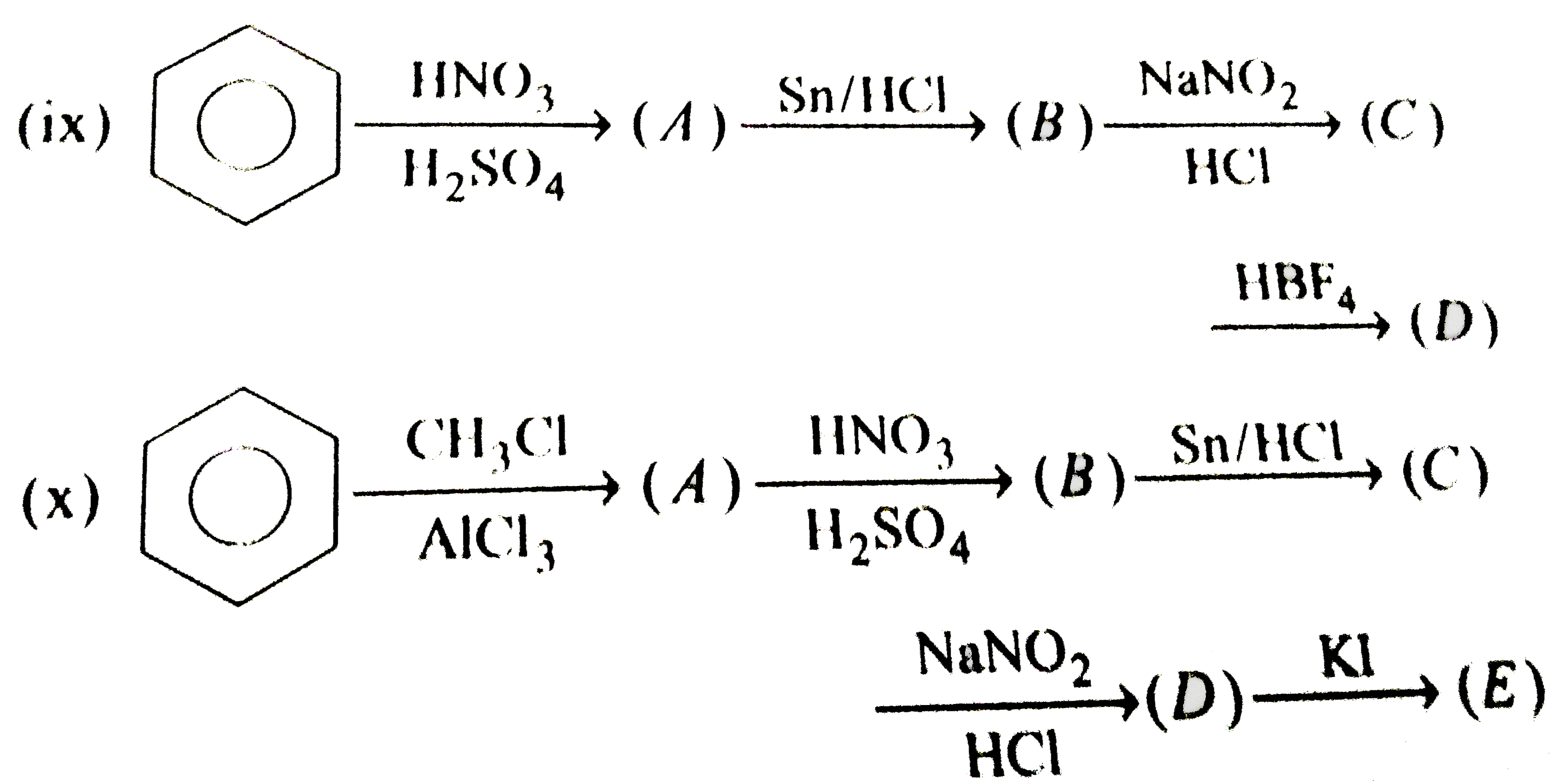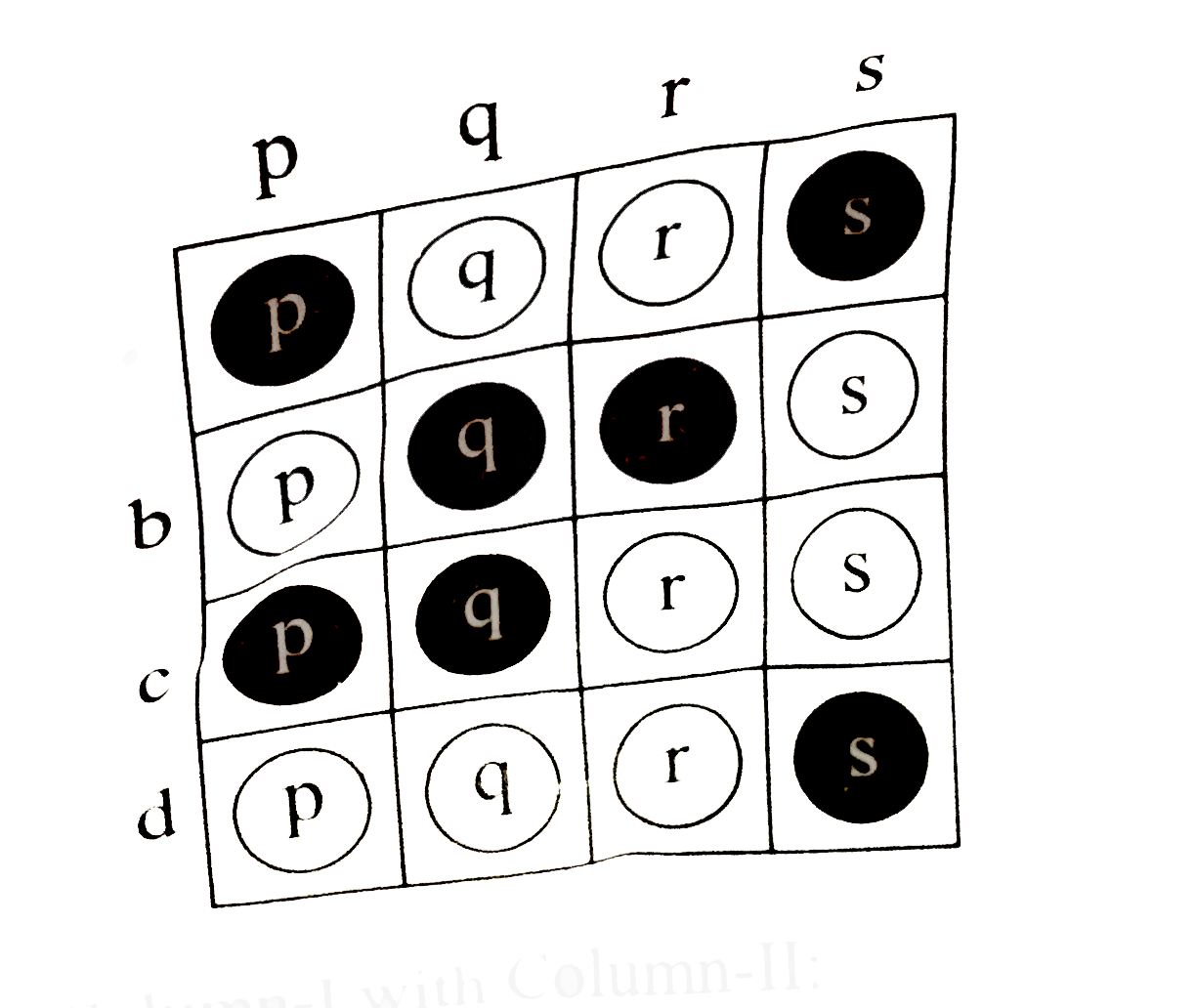Complete the following by providing (A),(B),(C) and (D) :
(i)CH3CH2CH2OHPBr−−→(A)alc.KOH−−−−−−→Δ
(B)HBr−−→(C)NH3−−→(D)
(ii)CH3CH2CH2Ialc.KOH−−−−−−→Δ(A)H+/H2O−−−−−→
(B)SOCI2−−−→(C)H−−−−−−→LiAIH4(D)
(iii)CH3CHBrCH3alc.KOH−−−−−−→Δ(A)HBr−−−−−−−→Peroxide
(B)Nal−−−−−−→Acetone(C)H−−−−−→Ether
(iv)CH3CH2CH=CH2NBS−−−−−→Light(A)alc.KOH−−−−−−→Δ(B)
HBr−−→(C)
(v)CH3CH2MgBrCH3CHO/H2O−−−−−−−−−→(A)HBr−−→(B)
alc.KOH−−−−−−→Δ(C)
(A)NH3−−→(B)CHCI3+KOH(alc.)−−−−−−−−−−−−−→(C)Na−−−−−−−→C2H5OH
CH3−C∣CH3H−NHCH3

(viii)CH3CH2Br(i)(CH2)6N4−−−−−−−−−−−→(ii)H2O/H+(A)NaOH−−−→(B)
(i)O3−−−−−−−−−−−→(ii)Zn/HOH(A)+(C)conc.NaOH−−−−−−−→(D)

(i)ACH3CH2CH2Br,(B)CH2CH=CH2,(C)CH3CHBrCH3,(D)CH3CHNH2CH3
(ii)(A)CH3CH=CH2,(B)CH3CHOHCH3,(C)CH3CHCICH3(D)CH3CH2CH3
(iii)(A)CH3CH=CH2,(B)CH3CH2CH2Br,(C)CH3CH2CH2I,(D)CH3CH2CH2Mgl.
(iv)(A)CH3CH(Br)CH=CH2,(B)CH2=CH−CH=CH2,(C)CH3CH(Br)CH=CH2 and CH3CH=CH−CH2Br
(A)CH3CH2CH(OH)CH3,(B)CH3CH2CH(Br)CH3,(C)CH3CH=CHCH3
(vi)(A)CH3−C∣CH3H−CI,(B)CH3−C∣CH3H−NH2,(C)CH3−C∣CH3H−NC

Topper's Solved these Questions
- HALOALKANES AND HALOARENES BOOK - OP TANDONCHAPTER - HALOALKANES AND HALOARENES EXERCISE - Matching type
2 Videos
- HALOALKANES AND HALOARENES BOOK - OP TANDONCHAPTER - HALOALKANES AND HALOARENES EXERCISE - Problems based on structure and properties
18 Videos
- HALOALKANES AND HALOARENES BOOK - OP TANDONCHAPTER - HALOALKANES AND HALOARENES EXERCISE - Problem
11 Videos
- ELECTROCHEMISTRYBOOK - OP TANDONCHAPTER - ELECTROCHEMISTRYEXERCISE - Matrix-Matching Type Question
3 Videos
- ISOMERISM (STRUCTURAL AND STEROISOMERISM)BOOK - OP TANDONCHAPTER - ISOMERISM (STRUCTURAL AND STEROISOMERISM)EXERCISE - INTEGER
7 Videos
Similar Questions
Match the following :
(i) (A)carbon tetrachloride1.Antiseptic(B)Chloretone2.Refrigerant(C)Westrosol3.Chloroform(D)Freon4.Polymer(E)Iodoform5.Hypnotic(F)Teflon6.Pyrene(G)Carbylamine reaction7.Solvent
(ii) (A)Acetone1.Plastic(B)Chloropicrin2.Gem-dihalide(C)PVC3.Vic-dihalide(D)RCHCI24.Iodoform test(E)CH2CI−CH2CI5.Grignard reagent(F)RMgX6.CHCI3+HNO3
View SolutionAn organic compound (A) C7H15CI on treatment with alcoholic caustic potash gives a hydrocarbon (B)C7H14(B) on treatment with ozone and subsequent hydrolysis gives acetone and butyraldehyde. What are (A) and (B)?
View SolutionHow do alkyl, allyl and vinyl halides differ in structure ?
View SolutionThis section contains 3 questions. Each question contains statement given in two columns which have to be matched. Statement (a, b, c and d) in Column-I have to be matched with statement (p, q, r and s) in Column-II. The answers to these questions have to be appropriately bubbled as illustrated in the following examples :
If the correct matches are (a-p, s), (b-q, r), (c-p, q) and (d-s), then correct bubbled 4×4 matrix should be as follows:

Match the column-I with Column-II :

View SolutionWrite the total number of cyclic structural as well as stereosiomers possible for a compound with the molecular formula C5H10.
View SolutionWrite the IUPAc name of the following compound :
(a) CH3−CH2−CH3∣CH−CH=CH−CH2−CH3
(b) CH3−CH2−CH3∣CH−CH2−CH3∣CH−CH∣CH2∣CH2∣CH−CH3∣CH3−CH=CH3∣C−CH3
View SolutionWrite the structures of monomers of the following polymers
(a) ⎡⎢ ⎢⎣−CH2−CH3∣C∣Ph−CH2−CH∣CN−⎤⎥ ⎥⎦n
(b) ⎡⎢ ⎢⎣−CH2−Cl∣C∣Cl−CH2−Cl∣C∣Cl−⎤⎥ ⎥⎦
( c) ⎡⎢ ⎢⎣−CH2−CH3∣C∣Ph−CH2−CH3∣C∣CN−⎤⎥ ⎥⎦.
View SolutionIn how many of the following reactions regioselectivity can be observed.
(I). CH3−CH3∣CH−CH2−Ohcon H2SO4−−−−−−−→Δ
(II). CH3−CH2−CH2−C∣OHH2Al2O3−−−→Δ
(III). CH3−CH3∣C−CH2−CH2−CH3alc.KOH−−−−−→Δ
(IV). CH3−CH2−C∣BrH−CH2−CH3Alc.KOH−−−−−→Δ
View SolutionCH_(3)-underset(CH_(3))underset(|)overset(CH_(3))overset(|)(CH)-overset(KMnO_(4))to (A) overset(H^(+))underset(Delta)to (B) overset(HBr) underset(RO OR) to (C) Product (C) in the above reaction is:
View SolutionCH_(3)-overset(O)overset(||)(C)-CH_(2)-CH_(2)-overset(O)overset(||)(C)-CH_(3) overset((NH_(4))_(2)CO_(3))underset(Delta) to (A) overset(C Cl_(3) CO_(2)Na) underset(Delta) to underset(("major"))((B)) Product (B) of above reaction is :
View SolutionCH3−CH3∣C∣OH−CH3∣C∣NH2−CH3HNO2−−−→Δ?
View SolutionComplete the missing links in the following
(i). CH3CH2CH2OHPBr3−−→[A]alc.KOH−−−−−→[B]HBr−−→[C]NH3−−→[D]
(ii). CH3CH2CH2Ialc.KOH−−−−−→[A]H+/H2O−−−−−→[B]SOCl2−−−→[C]LiAlH4−−−→[D]
(iii). CH3CHBrCH3alc.KOH−−−−−→[A]HBr−−−−→Peroxide[B]NaI−−−−→Acetone[C]Mg−−→Ether[D]
View SolutionCH_(3) overset(CH_(3))overset(|)underset(CH_(3))underset(|)(C) -Br overset(" KOH (alcoholic) ")underset(Delta)(to) (A) overset(HBr//R_(2)O_(2))(to) underset(("major"))((B)) (B) is
View SolutionComplete the following reactions: (i) CH_(3)-overset(CH_(3))overset(|)underset(Cl)underset(|)C-CH_(2)CH_(3) overset("alc"KOH) underset(Delta) to A overset(O_(3))underset(Zn//H_(2)O) to (B+C) (ii) CH_(3)overset(I)CH-CH_(3)overset("alc"KCN) to A underset((ii)H_(2)O.OH.H_(2)O_(2))overset((i)SnCl_(2)//HCl) to B (iii) HCN overset(HCl//AlCl_(3)) to A underset((ii) (H_(2)O)//H^(-))overset((i)C_(6)H_(6)Delta) to B (iv)
View SolutionIdentify the major product in the following reactions :
C6H5−CH2−H∣C∣Br−CH3Alc.KOH−−−−−→Δ?HBr−−→ ?
View Solution
